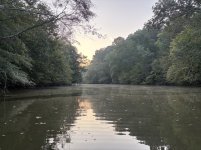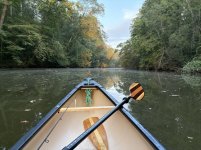During a recent two week trip paddling bow in my buddy’s Wenonah MN2 I had my first experience with a double blade. I was using my straight single blade and he was using his double blade. I found the slight side-to-side rocking of the canoe he caused disconcerting and then just plain bothersome after the first day. And my sense was we weren’t any faster than when he used his single blade.
-
Happy New Year 2026! 🕛🍾🥂
You are using an out of date browser. It may not display this or other websites correctly.
You should upgrade or use an alternative browser.
You should upgrade or use an alternative browser.
Thoughts on double bladed paddles from a somewhat experienced double blader.
- Thread starter Idiot Savant
- Start date
During a recent two week trip paddling bow in my buddy’s Wenonah MN2 I had my first experience with a double blade. I was using my straight single blade and he was using his double blade. I found the slight side-to-side rocking of the canoe he caused disconcerting and then just plain bothersome after the first day. And my sense was we weren’t any faster than when he used his single blade.
Reason #4,754 for paddling solo.
Alan
That's interesting Steve, I never thought of using a double blade for a pole, does it hold up in the long run?
I actually started poling swamps with my 250cm double blade before I got a pole. I still use the double to pole sometimes on back country trips when I don't have a pole. I wouldn't do it in a rocky creek or strong moving water, but my double has held up really well to pushing in muck and logs. I like its versatility, esp in the backcountry with a lot of portages and lake crossings. Paddling standing up also works well with the double, though its not particularly efficient there are times when it's handy (or just good to stretch).LOL. Nothing compares to a pole for going upstream.In fact, I routinely outrun double bladers even when I can't reach the bottom.
I'll have to ask if anyone wants to try pushing off the bottom with their double, and see if they can keep up.
And, I can use my double blade to get a line over branches to hang my food sack at camp - 250cm plus nearly the height of my reach, and no throwing and bouncing weights off the tree trunk and risking a snaggly snafu. I can't reach nearly as high with a 60in single blade (though of course the 12ft pole beats all!)
And, no Steve, I will not be engaging in any poling races where you have a pole and I'm poling with a double blade. But I imagine you'd beat me even if we both had poles.
People are constantly surprised at how well a 12' pole works as the paddle. But part of the trick is that while standing you can have a lot of pole in the water simply by bending more at the knees, and the power portion of the stroke can be longer than that of a seated double paddler without inducing as much yaw.
But if you think your double paddle gets you wet, that's nothing compared to using both ends of the pole.
But if you think your double paddle gets you wet, that's nothing compared to using both ends of the pole.
Chillin at Smith Lake this evening. Found a tiny spot of National Forest shoreline to claim. This
Is a huge Mountain Reservoir that used to have miles and miles of undeveloped shoreline but these days finding a remote campsite is tough. Tried the 250-265 DB for a while today into a 5-10 mph headwind. iDK, I seem to still get significant water in the boat and on me if I dig in and try to get up any speed. Doing the wide shallow piddle paddle didn’t seem to get me anywhere. Went back to the beavertail. Maybe I’m doin it wrong.

Is a huge Mountain Reservoir that used to have miles and miles of undeveloped shoreline but these days finding a remote campsite is tough. Tried the 250-265 DB for a while today into a 5-10 mph headwind. iDK, I seem to still get significant water in the boat and on me if I dig in and try to get up any speed. Doing the wide shallow piddle paddle didn’t seem to get me anywhere. Went back to the beavertail. Maybe I’m doin it wrong.

- Joined
- Aug 10, 2018
- Messages
- 2,072
- Reaction score
- 6,908
IMO, you can never go too far wrong with a beavertail.
Sounds to me like you're doing it right!Went back to the beavertail. Maybe I’m doin it wrong.
Ah yes, referred to as animal tails in some circles, the beavertail paddle still is a very good choice for the average tripper who doesn’t count peaks or heart rates.
Now let's do beaver vs otter.Ah yes, referred to as animal tails in some circles, the beavertail paddle still is a very good choice for the average tripper who doesn’t count peaks or heart rates.
I gave away my beavertail after trying the modified ottertail.
I would have appreciated an otter tail on the deep flat water of the lake I was just on, but the beaver performed admirably.
I believe the advantage of the long blade ottertail is, in expert hands, the leverage applied at the tip is useful for certain maneuvers.
The reality is that there is not a lot of actual difference between an OtterTail and a BeaverTail
The reality is that there is not a lot of actual difference between an OtterTail and a BeaverTail
For lake use I believe you are correct. For rivers with shallow sections where the whole paddle blade can’t be fully submerged, the beaver tail has a pretty big advantage with the width carried further down the blade. Of course, an even shorter, wider, and ideally more gravel resistant paddle would be the best choice there, but I have often taken both and switched between a beaver tail in the deep sections and a different paddle for the shallow swift sections. Occasionally though I’m daydreaming and don’t switch fast enough so you gotta use whatcha got, which is why I don’t own an otter tail, although they look lovely to use.
I often bring an ottertail and a pole or two in the tandem. Anywhere I can't use the big paddle without harming it, I just pole.
I'll add an additional advantage of long blade wood paddles, otter, voyageur and the like, especially if they are finished with thin knife slicing edges. If when cruising you favor the Canadian/Northwoods correction stroke, as do I, with underwater recovery, these paddles are what will give the best performance and joy. Although you can do a b*st*rdized Canadian with a bent, it is awkward at best and not fun for the long haul.
I've mentioned this before. The long blade does a pretty good imitation of a sailboat keel when paddling broadside to the wind. The most efficient deep keels are long and narrow, like a sailplane wing. My gut tells me (having compared but not measured scientifically) that this carries over to canoe paddles when used in those conditions. But mostly, I like having the ridiculously long blade option - and a beavertail of similar dimensions would be unwieldy, I think.
I set out at daylight and put in about 6 miles on the very calm creek near my house. I used the DB 75% of the time. Didn't get in any hurry just piddle paddled w short shallow easy strokes with the paddle kept low as possible, at least most of the time, trying to see how dry I could keep the boat and myself. This method moved me right along in these conditions with no wind, as fast or faster than a single really without working hard at all. Only got around 1/8" of water in the deepest part of the boat right under me. Not a big deal when the weather is warm but come winter it's prob gonna annoy me. When I switched to the single and dug in with intention I went faster. Seems the DB is gonna be good for a lazy but pretty decent pace on protected water in warm weather. Also think the DB is a bit easier to manage while fishing, it balances in my lap or across the boat.




I use ( on occasion) a DB in day paddling and tripping. At first, I kept that truth pretty quiet. But the way I paddle it just makes sense. Going up river against a 3 mph current it is just so much nicer … especially after a couple of miles. Paddling current in Florida while Manatee watching … and trying to keep up with my wife who paddles a Flashfire in Florida. Also, tripping open water in bad weather with an older dog who moves about often, changing trim in the boat. 90 percent of the time I utilize a beaver tail type paddle and the guide stroke, but when conditions make forward progress very difficult, or when I need to eat up miles in a hurry - the DP is an efficient tool for me. I utilize a low angle, “ Lilly dipping “ stroke which keeps water out of my lap and does not sling water on my dog’ head.
When I could kneel, I had more than enough power and endurance that a DP was never needed. As a dedicated sitter … who is older … a DP keeps me in the game.
When I could kneel, I had more than enough power and endurance that a DP was never needed. As a dedicated sitter … who is older … a DP keeps me in the game.
Yup … it is out there Martin. Hi, my name is Bob … and I use a Double Paddle.
Similar threads
- Replies
- 40
- Views
- 3K
